Influence of Dual Air Gaps on Flux–Torque Regulation Hybrid Excitation Machine with Axial–Radial Magnetic Circuit
Abstract
1. Introduction
2. Topology and Operating Principle of the FTRHEM
2.1. Machine Topology
2.2. Principle of Machine Flux Regulation Based on Magnetic Network
2.3. Principle of Additional Torque
3. Study of the Air Gap’s Effect on the Performance of the FTRHEM
3.1. Air Gap Equivalent Models
3.2. The Influence of the Air Gap on the Flux Performance
3.3. The Influence of the Air Gap Length Ratio on the Machine Performance
4. Experimental Validation of the FTRHEM
5. Conclusions
- The radial air gap and axial air gap of the FTRHEM have different effects on the magnetic field and the additional torque. The effect of the axial air gap on the flux regulation capability and additional torque is more significant than that of the radial air gap.
- As the radial air gap increases, the radial EMF decreases, the axial EMF increases, the flux regulation capability is enhanced, and the additional torque increases. When the radial air gap increases from 0.35 to 0.95 mm, the flux regulation capability decreases from 20.87% to 23.32%, and the additional torque increases by 31.05%.
- As the axial air gap increases, the radial EMF increases, the axial EMF decreases, the flux regulation capability decreases, and the additional torque increases. When the axial air gap increases from 0.35 mm to 0.95 mm, the flux regulation capability decreases from 26.51% to 15.44%, and the additional torque decreases by 40.77%.
- The air gap length ratio of the FTRHEM has a great influence on the machine’s flux regulation and additional torque performance. As the air gap length ratio decreases, the machine’s flux regulation capability increases, and the additional torque increases. After clarifying the effect of the air gap on the magnetizing capability as well as the additional torque capability, the performance of the FTRHEM can be further optimized.
Author Contributions
Funding
Data Availability Statement
Conflicts of Interest
References
- Zhu, Z.Q.; Howe, D. Electrical Machines and Drives for Electric, Hybrid, and Fuel Cell Vehicles. Proc. IEEE 2007, 95, 746–765. [Google Scholar] [CrossRef]
- Chau, K.T.; Chan, C.C.; Liu, C. Overview of Permanent-Magnet Brushless Drives for Electric and Hybrid Electric Vehicles. IEEE Trans. Ind. Electron. 2008, 55, 2246–2257. [Google Scholar] [CrossRef]
- Palka, R.; Cierzniewski, K.; Wardach, M.; Prajzendanc, P. Research on Innovative Hybrid Excited Synchronous Machine. Energies 2023, 16, 6600. [Google Scholar] [CrossRef]
- Wang, K.; Zhang, L. Integrated design of high-speed permanent-magnet machines considering sensor less operation. IEEE Trans. Electr. Electron. Eng. 2018, 13, 1931–4973. [Google Scholar] [CrossRef]
- Bai, H.; Yu, B. Position Estimation of Fault-Tolerant Permanent Magnet Motor in Electric Power Propulsion Ship System. IEEE Trans. Electr. Electron. Eng. 2022, 17, 890–898. [Google Scholar] [CrossRef]
- Zhang, Z.; Yan, Y.; Yang, S.; Bo, Z. Principle of Operation and Feature Investigation of a New Topology of Hybrid Excitation Synchronous Machine. IEEE Trans. Magn. 2008, 44, 2174–2180. [Google Scholar] [CrossRef]
- Qiu, H.; Yu, W.; Tang, B.; Mu, Y.; Li, W.; Yang, C. Study on the Influence of Different Rotor Structures on the Axial-Radial Flux Type Synchronous Machine. IEEE Trans. Ind. Electron. 2018, 65, 5406–5413. [Google Scholar] [CrossRef]
- Ayub, M.; Jawad, G.; Kwon, B. Consequent-pole hybrid excitation brushless wound field synchronous machine with fractional slot concentrated winding. IEEE Trans. Magn. 2019, 55, 8203805. [Google Scholar] [CrossRef]
- Zhang, G.; Song, N.; Zhou, G.; Zhu, M.; Guo, L.; Li, H. Based on the comparative analysis of the length of the air gap length of the finite element simulation permanent magnet synchronous motor. In Proceedings of the 2022 25th International Conference on Electrical Machines and Systems (ICEMS), Chiang Mai, Thailand, 29 November–2 December 2022; pp. 1–6. [Google Scholar] [CrossRef]
- Yung, C.; Griffith, J.T. The Effect of air gap on Electric Motor Performance: Copyright Material IEEE, Paper No. PCIC-2018-49. In Proceedings of the 2018 IEEE Petroleum and Chemical Industry Technical Conference (PCIC), Cincinnati, OH, USA, 24–26 September 2018; pp. 435–442. [Google Scholar] [CrossRef]
- Valtonen, M.; Parviainen, A.; Pyrhonen, J. Influence of the air-gap length to the performance of an axial-flux induction motor. In Proceedings of the 2008 18th International Conference on Electrical Machines, Vilamoura, Portugal, 6–9 September 2008; pp. 1–5. [Google Scholar] [CrossRef]
- Li, J.; Qu, R.; Cho, Y.-H. Effect of unbalanced and inclined air-gap in double-stator inner-rotor axial flux permanent magnet machine. In Proceedings of the 2014 International Conference on Electrical Machines (ICEM), Berlin, Germany, 2–5 September 2014; pp. 502–508. [Google Scholar] [CrossRef]
- Liu, C.; Si, J.; Zhang, W.; Li, Y.; Hu, Y. Electromagnetic Characteristics Analysis in Double-Sided Permanent Magnet Linear Synchronous Motor with Asymmetrical Air-Gap. IEEE Trans. Electr. Electron. Eng. 2022, 17, 1798–1810. [Google Scholar] [CrossRef]
- Zhang, Z.; Ma, S.; Dai, J.; Yan, Y. Investigation of Hybrid Excitation Synchronous Machines with Axial Auxiliary Air-Gaps and Non-Uniform Air-Gaps. IEEE Trans. Ind. Appl. 2014, 50, 1729–1737. [Google Scholar] [CrossRef]
- Qiu, H.; Yuan, C.; Chen, W.; Ma, X.; Xiong, B. Combined Regulation Performance Research of the Novel Flux-Torque Regulation Hybrid Excitation Machine with Axial-Radial Magnetic Circuit. IEEE Trans. Transp. Electrif. 2024. [Google Scholar] [CrossRef]
- Qiu, H.; Zhang, Y.; Ma, X.; Yang, C. Operating principle and performance analysis of a novel flux–torque regulation hybrid excitation machine with axial–radial magnetic circuit using magnetic network. IET Electr. Power Appl. 2023, 17, 824–834. [Google Scholar] [CrossRef]
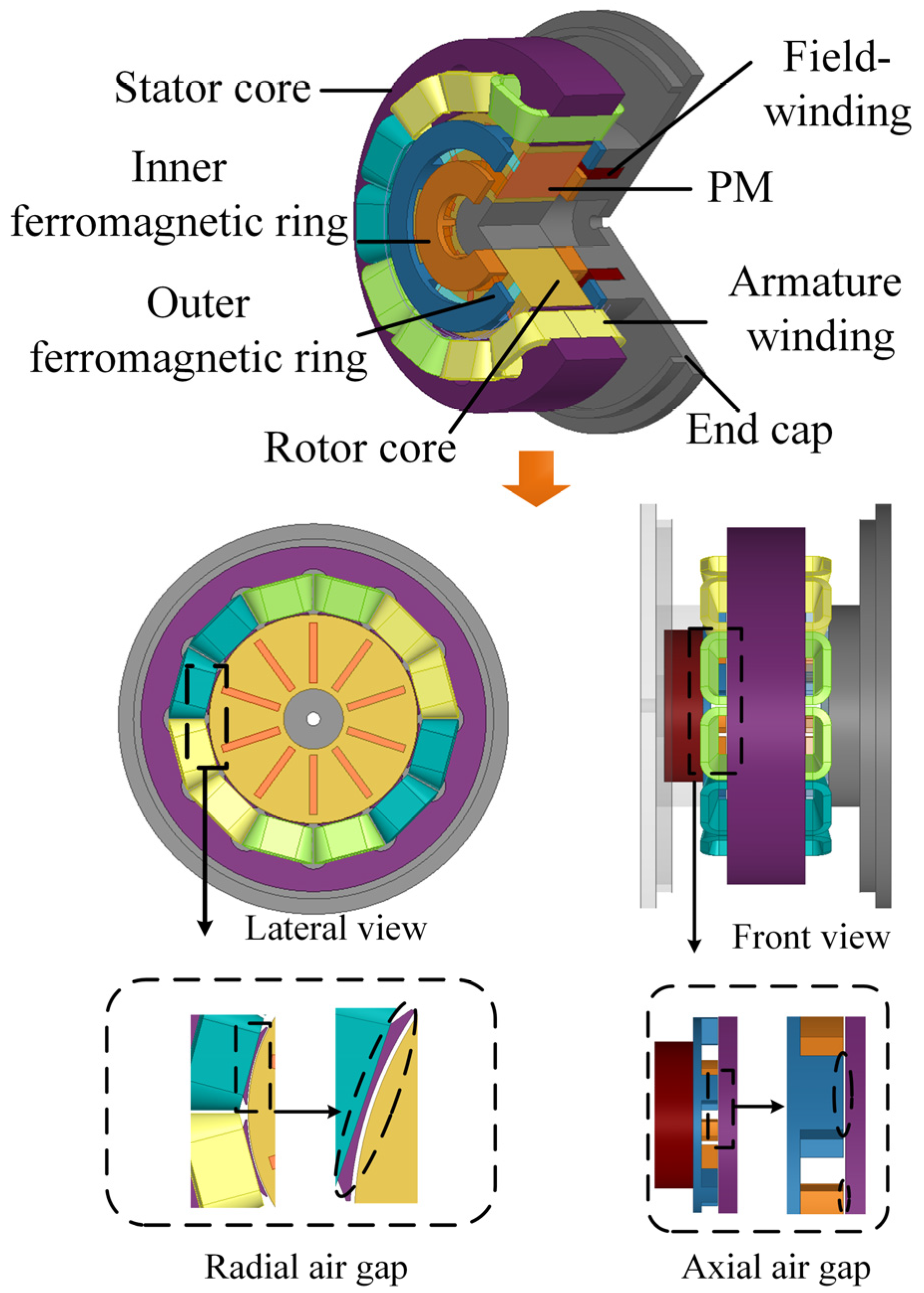
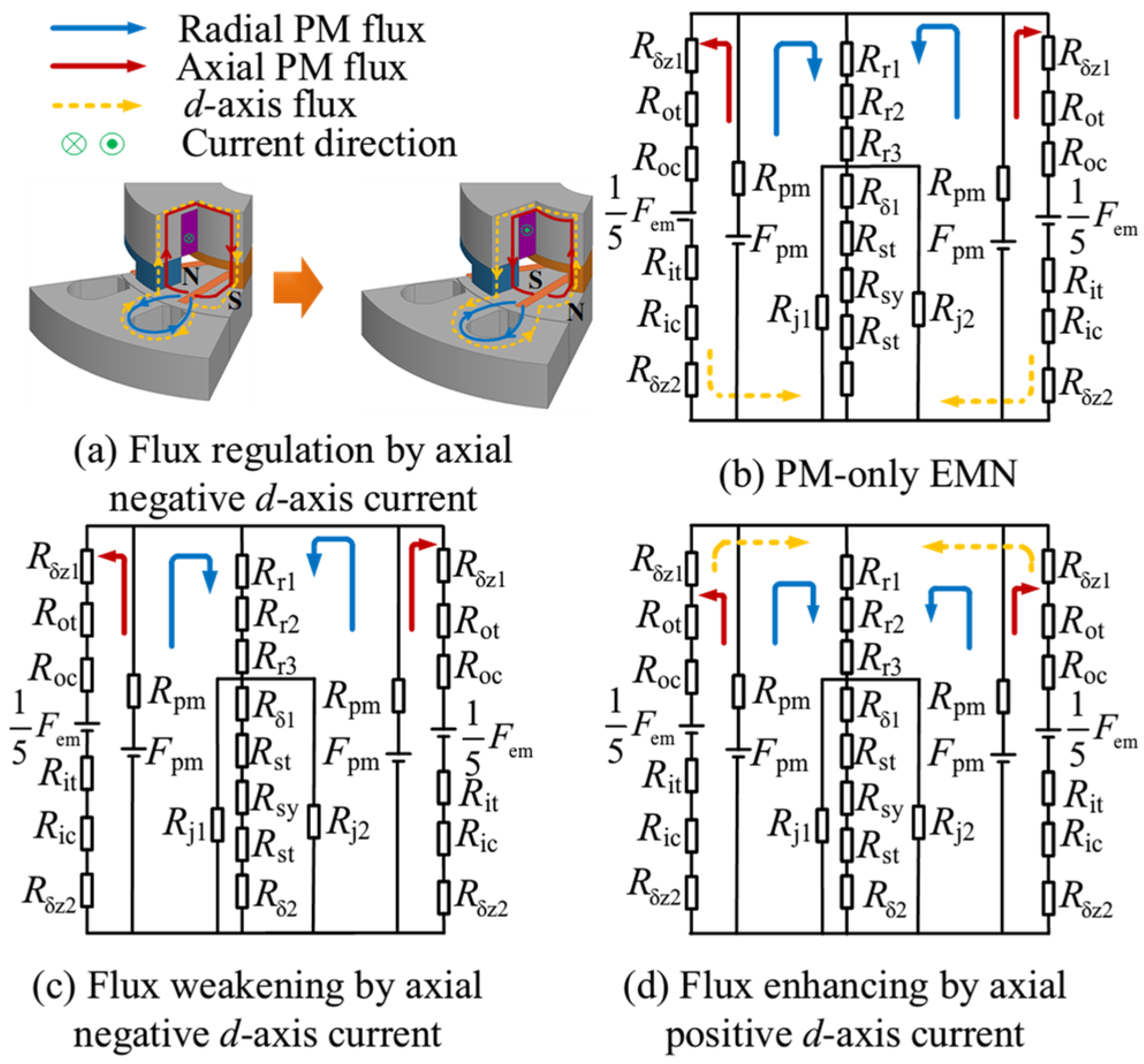
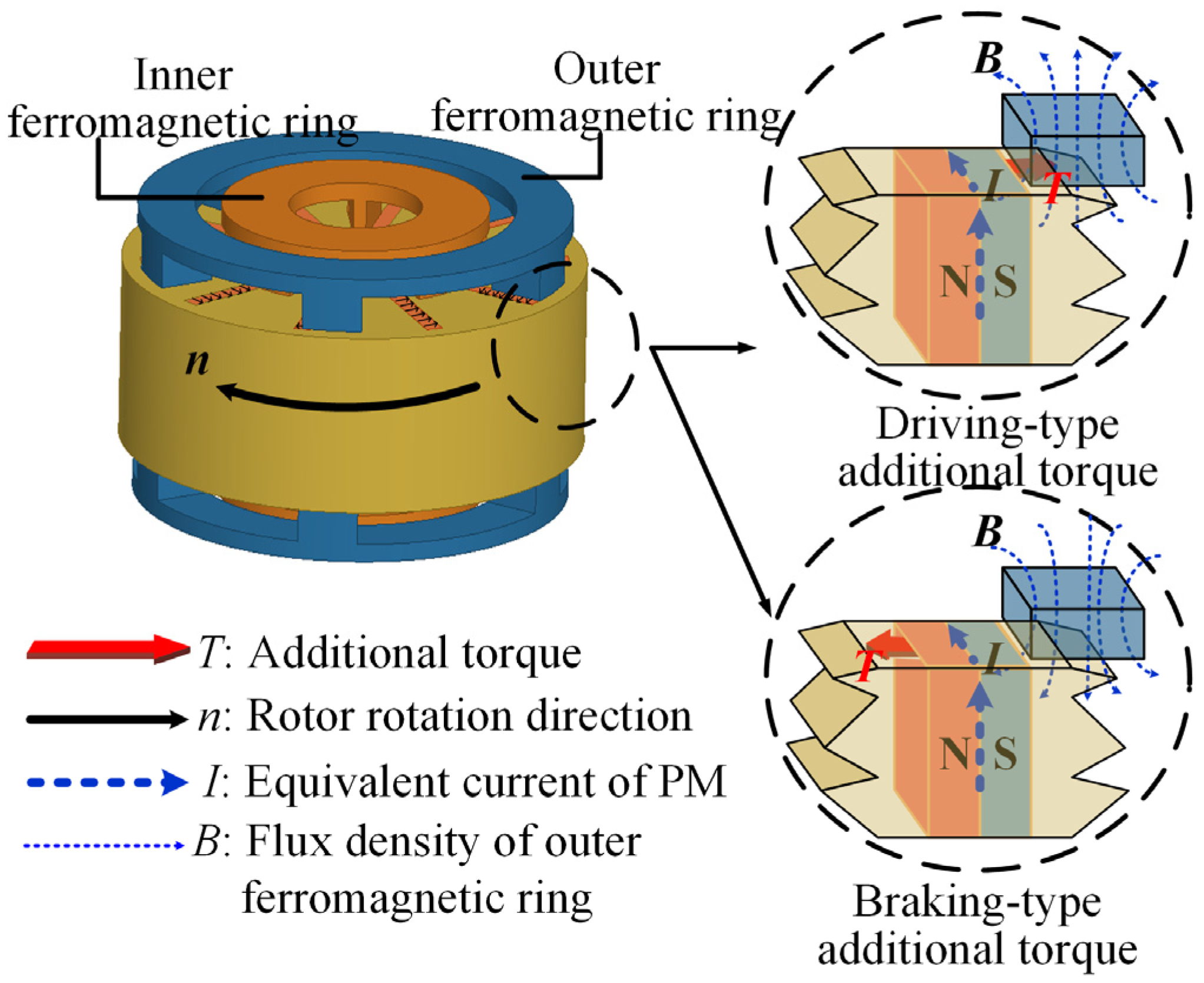

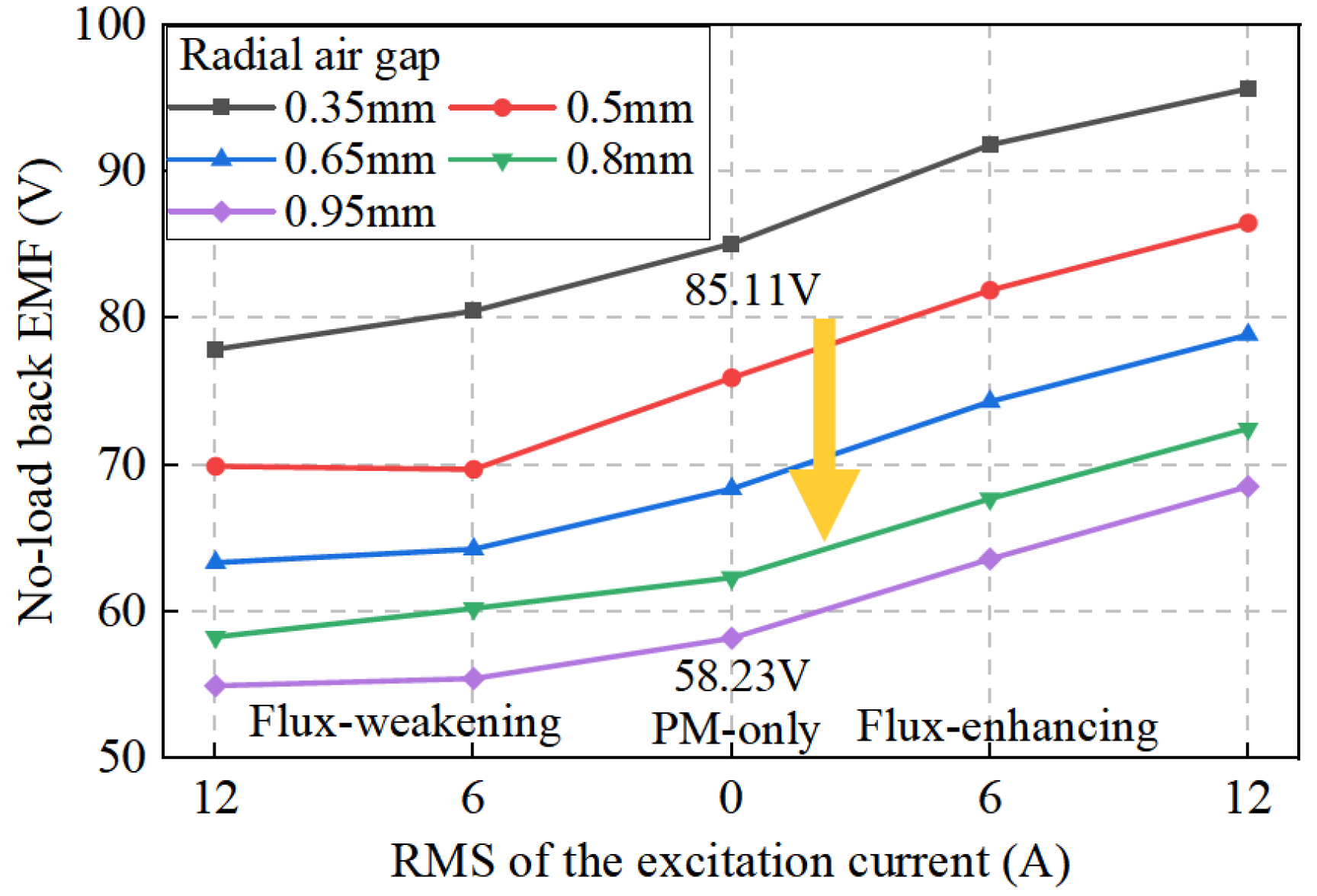
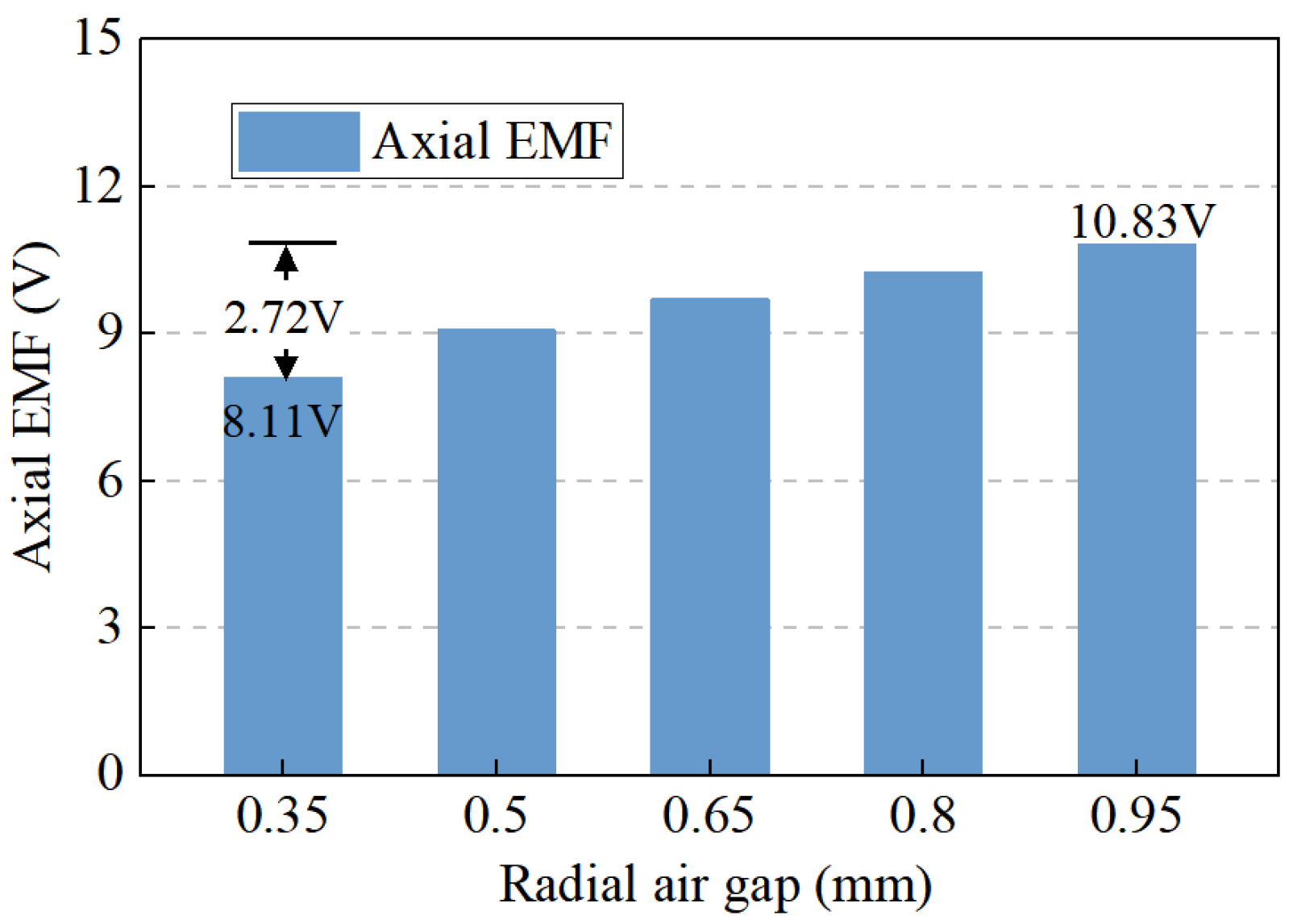
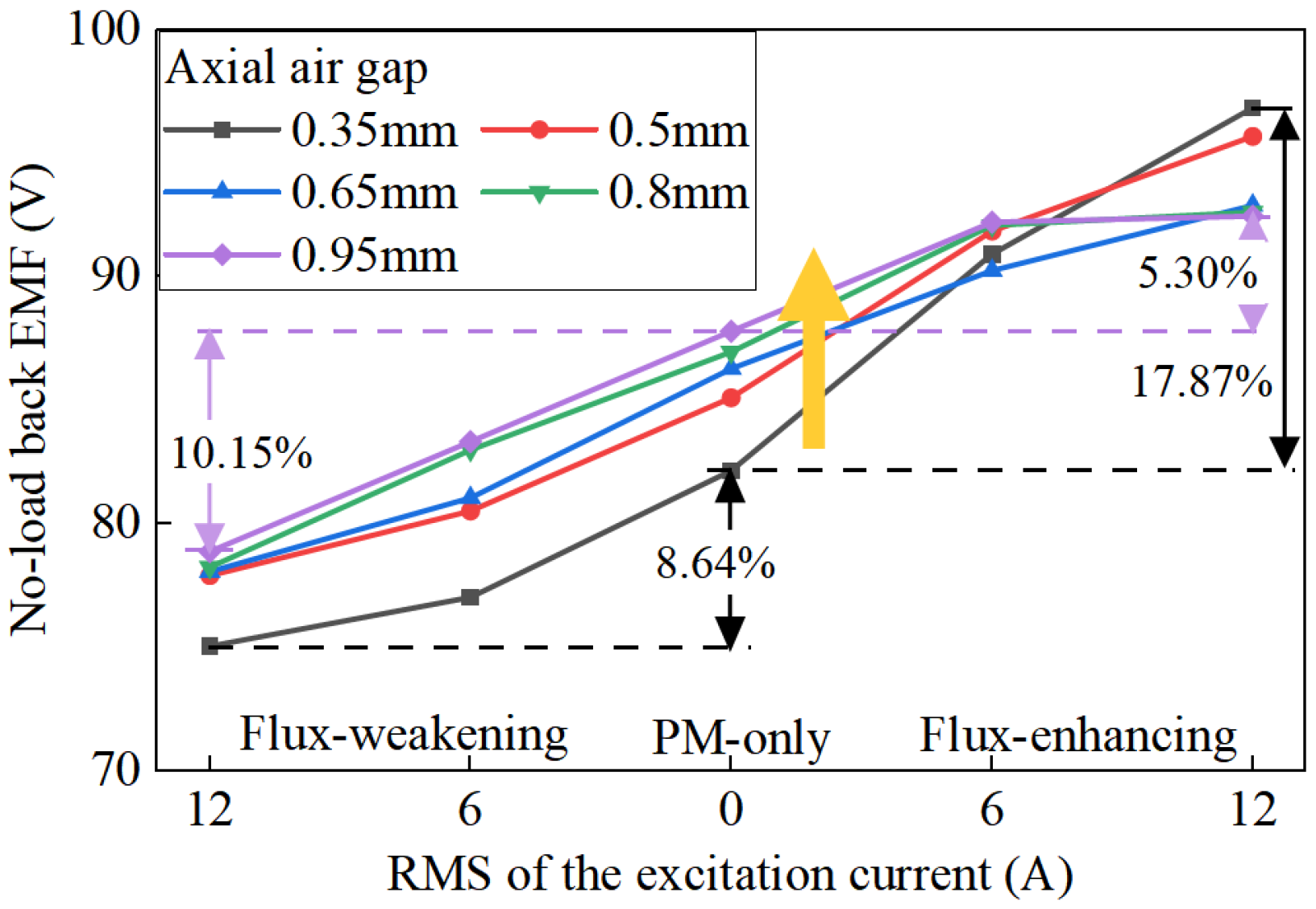

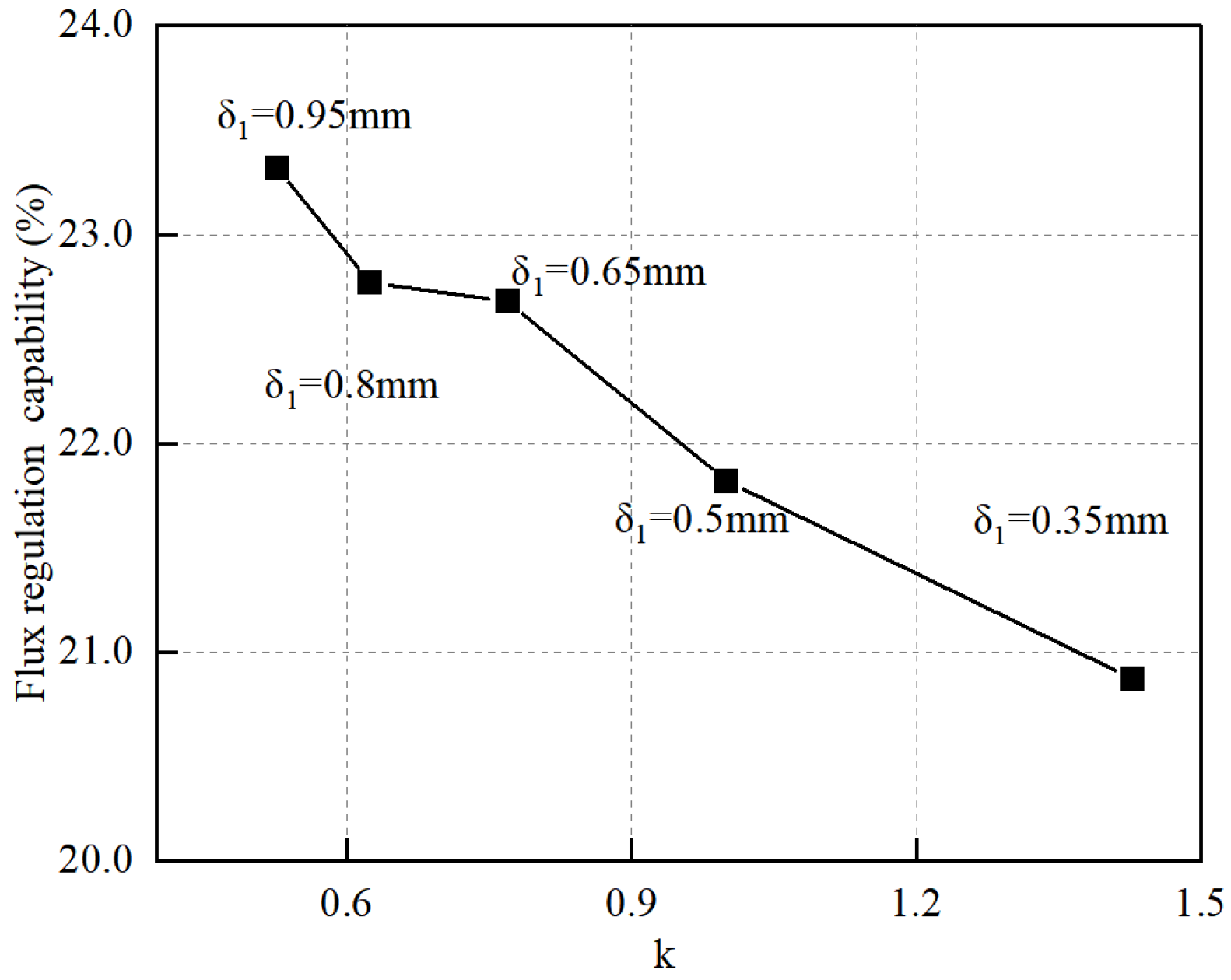
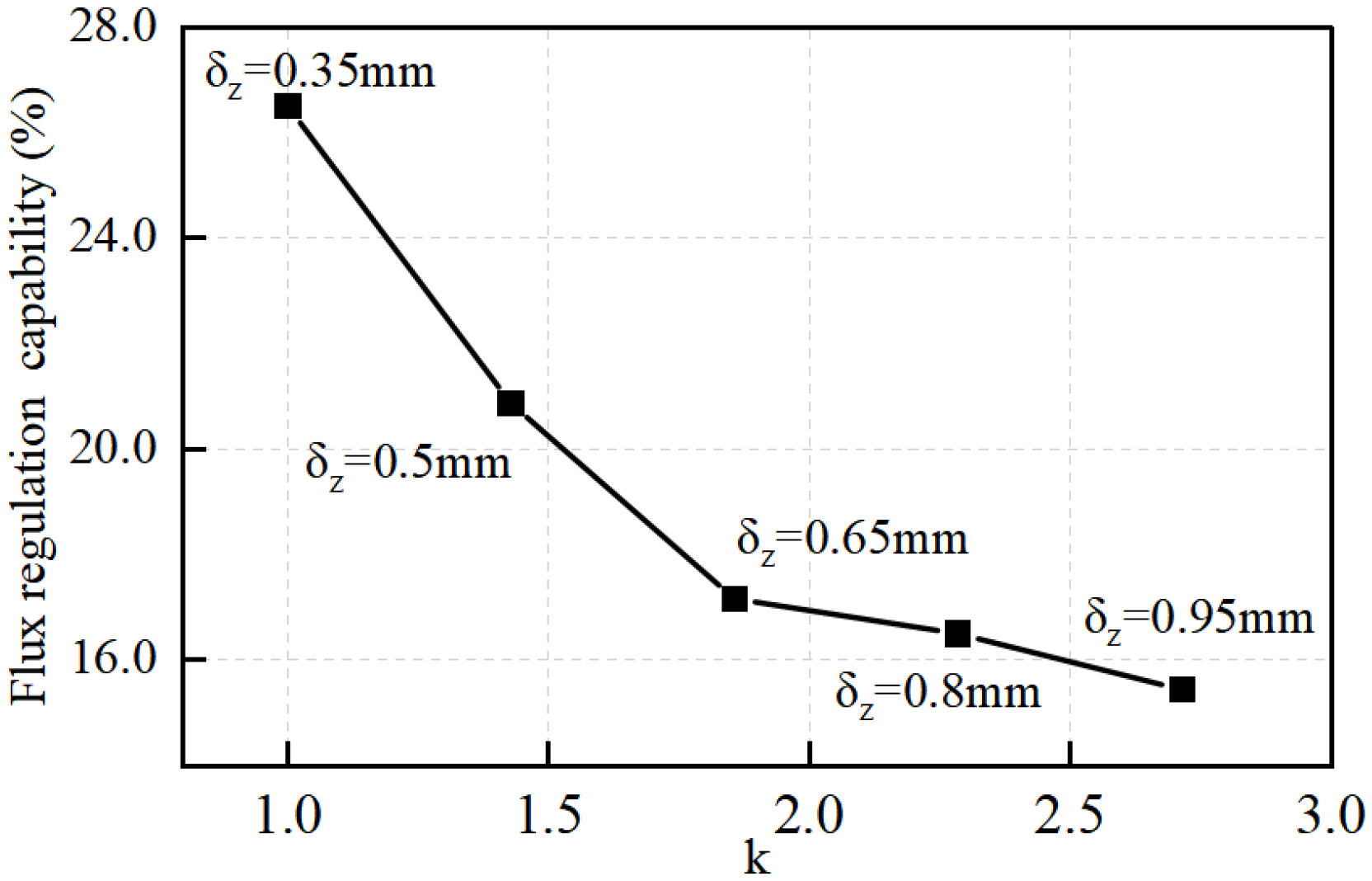



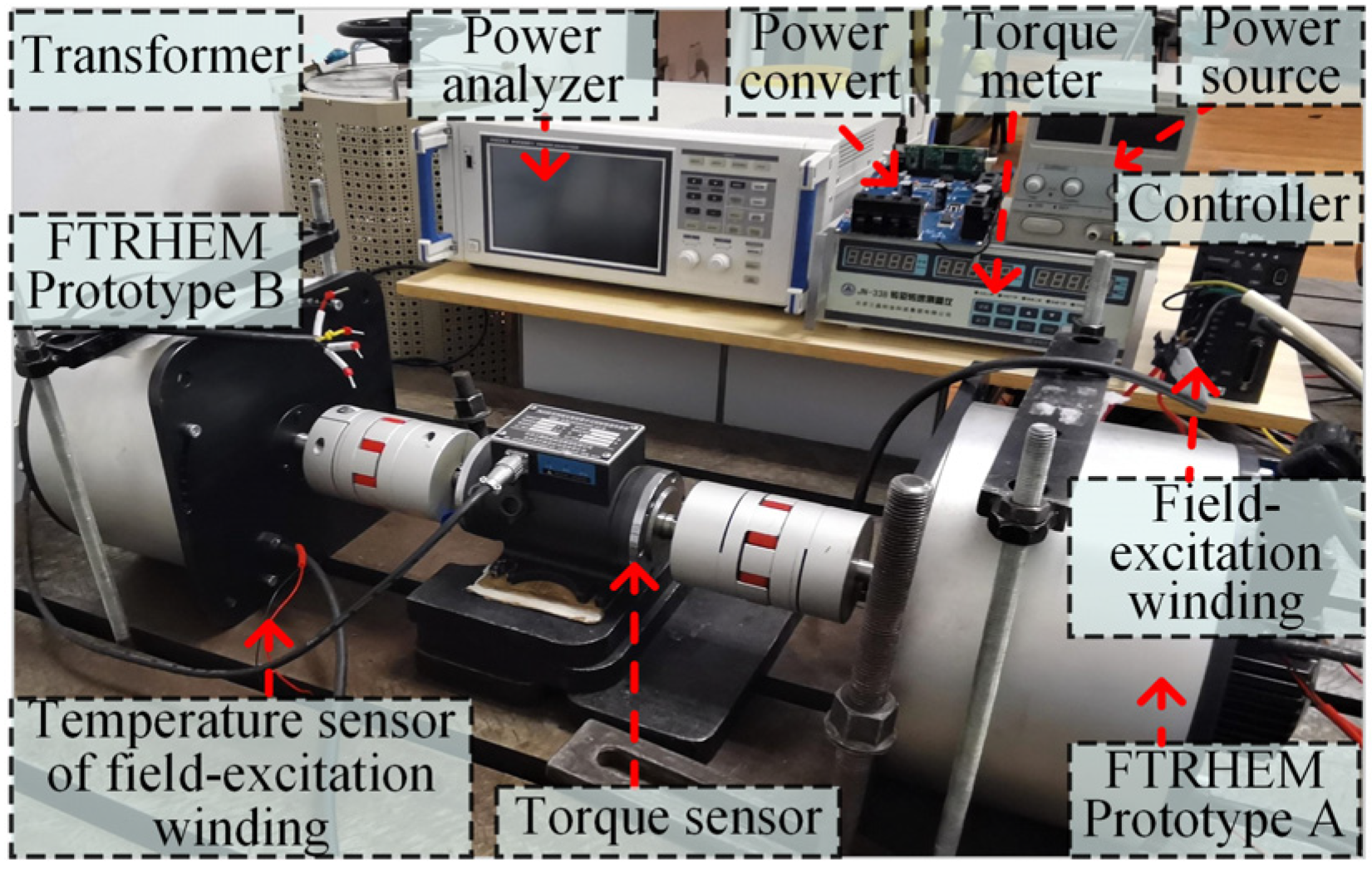


| Symbols | Meaning | Symbols | Meaning |
|---|---|---|---|
| MMF by PM | MMF by field winding | ||
| PM reluctance | Main air gap reluctances | ||
| Stator tooth reluctance | Yoke reluctance | ||
| Leakage reluctances between poles | Axial air gap reluctances | ||
| Outer ferromagnetic ring claw pole reluctance | Outer ferromagnetic ring reluctance | ||
| Inner ferromagnetic ring claw pole reluctance | Inner ferromagnetic ring reluctance | ||
| Rotor reluctance of three parts | Simplified reluctances |
| Magnetic Flux | Item | ||
|---|---|---|---|
| Total value | ↓ | ↑ | |
| First term of the expression | ↓ | ↑ | |
| Second term of the expression | ↓ | ||
| Total value | ↑ | ||
| First term of the expression | ↓ | ↑ | |
| Second term of the expression | ↓ | ↓ | |
| Total value | ↓ |
| Parameters | Values |
|---|---|
| Number of pole-slot number | 10/12 |
| Outer diameter of stator | 230 (mm) |
| Inner diameter of stator | 140 (mm) |
| Width of magnets | 5 (mm) |
| Length of magnets | 40 (mm) |
| RMS of Excitation Current (A) | 3D FEA Results | Measured Results |
|---|---|---|
| 2 | 4.96% | 5.00% |
| 4 | 9.51% | 9.86% |
| 6 | 13.09% | 12.66% |
| 8 | 16.38% | 15.71% |
| RMS of Excitation Current (A) | 3D FEA Results (Nm) | Measured Results (Nm) |
|---|---|---|
| 2 | 2.51 | 1.99 |
| 4 | 4.54 | 3.70 |
| 6 | 6.41 | 5.27 |
| 8 | 8.21 | 6.87 |
Disclaimer/Publisher’s Note: The statements, opinions and data contained in all publications are solely those of the individual author(s) and contributor(s) and not of MDPI and/or the editor(s). MDPI and/or the editor(s) disclaim responsibility for any injury to people or property resulting from any ideas, methods, instructions or products referred to in the content. |
© 2024 by the authors. Published by MDPI on behalf of the World Electric Vehicle Association. Licensee MDPI, Basel, Switzerland. This article is an open access article distributed under the terms and conditions of the Creative Commons Attribution (CC BY) license (https://creativecommons.org/licenses/by/4.0/).
Share and Cite
Dai, Y.; Zheng, Y.; Yuan, C.; Zhang, Y.; Qiu, H. Influence of Dual Air Gaps on Flux–Torque Regulation Hybrid Excitation Machine with Axial–Radial Magnetic Circuit. World Electr. Veh. J. 2024, 15, 430. https://doi.org/10.3390/wevj15090430
Dai Y, Zheng Y, Yuan C, Zhang Y, Qiu H. Influence of Dual Air Gaps on Flux–Torque Regulation Hybrid Excitation Machine with Axial–Radial Magnetic Circuit. World Electric Vehicle Journal. 2024; 15(9):430. https://doi.org/10.3390/wevj15090430
Chicago/Turabian StyleDai, Yong, Yifeng Zheng, Chunwei Yuan, Yuqing Zhang, and Hongbo Qiu. 2024. "Influence of Dual Air Gaps on Flux–Torque Regulation Hybrid Excitation Machine with Axial–Radial Magnetic Circuit" World Electric Vehicle Journal 15, no. 9: 430. https://doi.org/10.3390/wevj15090430
APA StyleDai, Y., Zheng, Y., Yuan, C., Zhang, Y., & Qiu, H. (2024). Influence of Dual Air Gaps on Flux–Torque Regulation Hybrid Excitation Machine with Axial–Radial Magnetic Circuit. World Electric Vehicle Journal, 15(9), 430. https://doi.org/10.3390/wevj15090430





